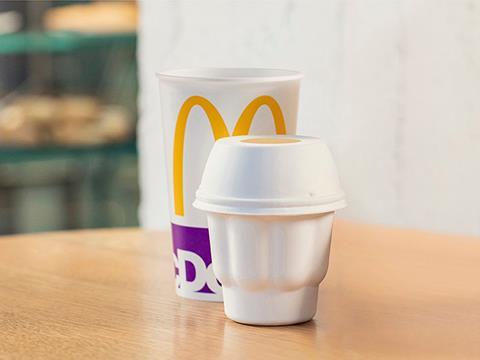
To learn more about Huhtamaki’s new Sundae cup for McDonald’s made from 100% wood fiber, we caught up with Neal McCone, Category Director QSR and Speciality Coffee for Huhtamaki Fiber Foodservice Europe, Asia, Oceania.
Congratulations on being selected by the international judging panel as a Sustainability Awards 2021 finalist! Could you please introduce your successful entry and what’s innovative about it?
The successful entry is a specifically engineered Sundae Cup & Lid that we developed in partnership with Havi for McDonald’s to be used throughout Europe initially. The product is made from 100% wood fiber, without any plastic additives and has been formulated for use with ice cream and a broad range of sauces and toppings.
The product needed to be engineered to very high performance tolerances, demonstrate superior functionality and organoleptic properties and also provide the consumer with a highly evolved level of sensory perception in use. We see this product not as a ‘good replacement for plastic’, but as a fantastic sustainable design and a beautiful piece of packaging in its own right.
What are the environmental challenges in packaging that your entry addresses, and what impact do you hope it will make?
The initial need was to replace an existing, brand-iconic, plastic package made from non-renewable materials. Our Circular design addresses the consumer (and increasingly legislative) demand for a switch to renewable materials by using tree fiber from sustainably managed forests, utilising efficient manufacturing processes that reprocess all scrap and wastage and ending with a consumer and operator validated package that can be recovered in existing paper streams, have the high-value material within it captured, and then recycled.

I’d like to ask you about the broader picture beyond your successful entry. ‘Sustainability’ in packaging is multi-dimensional – both in terms of objectives and challenges. Could you comment on the most important roadblocks you identify from your position in the value chain, and the kinds of solutions you would like to see addressing them (e.g. areas of technological innovation, collaboration, regulation)?
The objectives that our industry is faced with delivering are laudable, as we aspire to take a ‘whole system’ approach to the packaging we produce. This means we must look beyond a simple raw material switch when we are designing for sustainability, towards a better understanding of whole life cycles for the product, the raw materials chosen, operational methods, energy efficiency and validation of manufacturing footprints.
Regional recycling infrastructures also need to be evolved to ensure that used materials can be effectively captured and given another use by unlocking inherent raw material value.
We need to develop independent scientific comparison tools to allow transparent validation of the choices made in the name of true sustainability that take all the positive and negative parameters into consideration so that consumer trust can be built upon these new packaging and system directions.
So for me, the key challenges go beyond the obvious complexity, infrastructure development and cost considerations associated with establishing new manufacturing categories and focus on fully educating ourselves in the industry, legislators and decision-makers at country level and ultimately consumers to make sure we take the best possible decisions on the journey to truly sustainable packaging.











